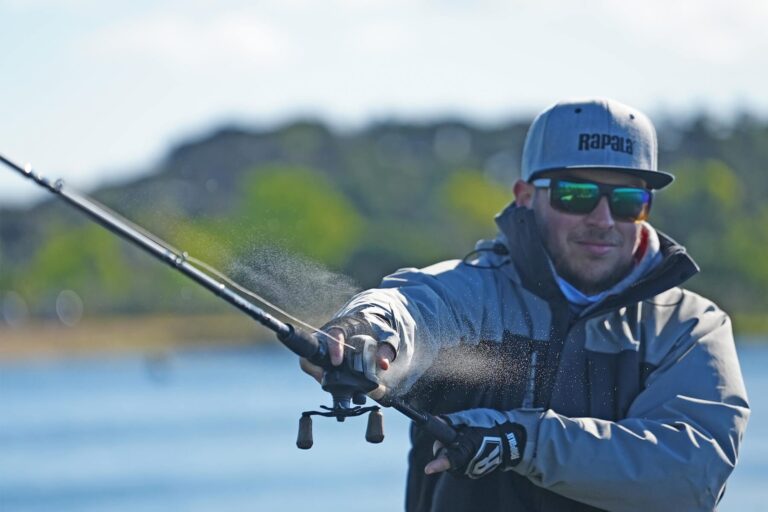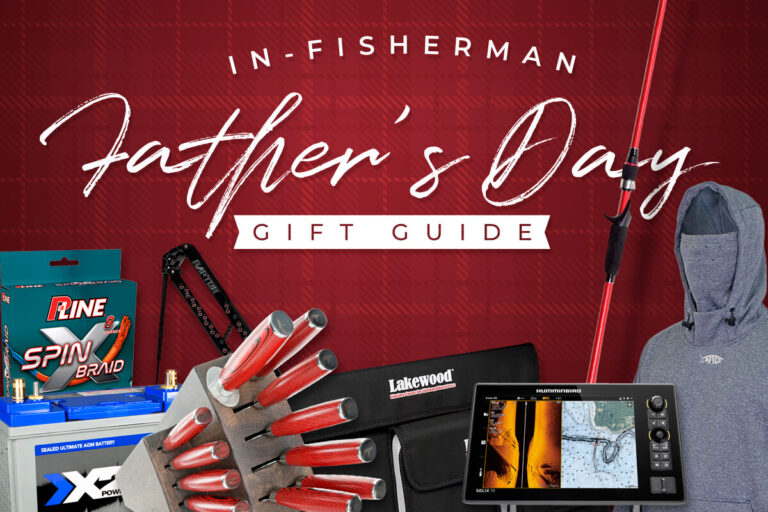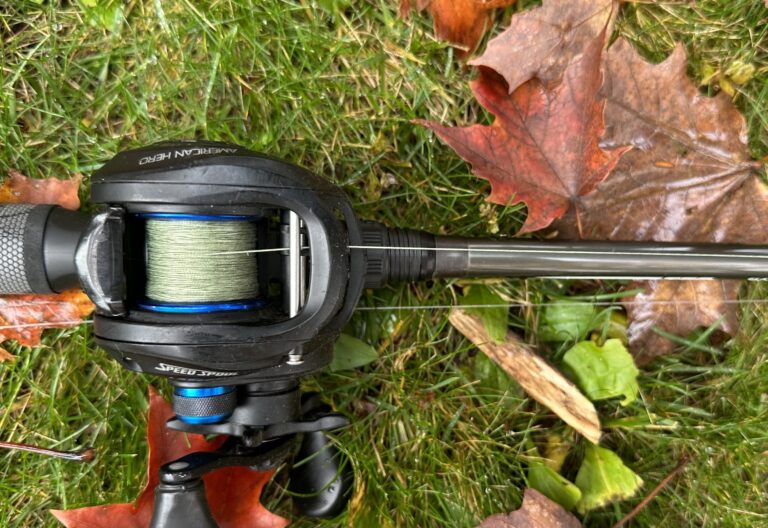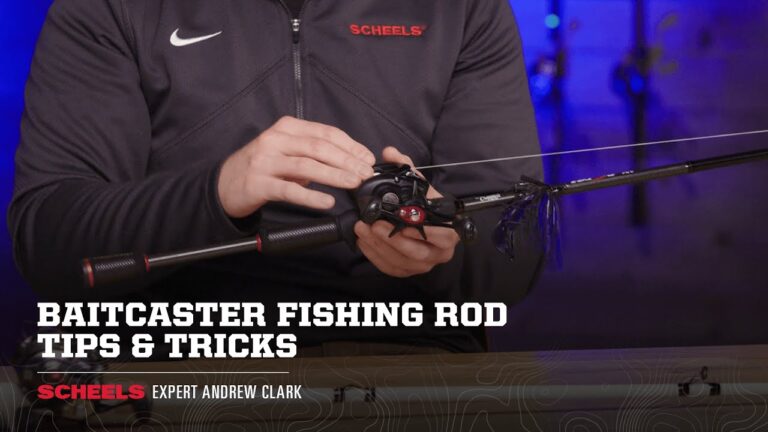To adjust a baitcasting reel, start by loosening the tension knob and setting the brake system to a medium setting, then practice casting to fine-tune the adjustments until the reel performs optimally. Baitcasting reels are popular among anglers for their accuracy and control.
However, to get the most out of these reels, it’s essential to know how to adjust them properly. Adjusting a baitcasting reel involves setting the tension knob and brake system to achieve the desired casting performance. By following a few simple steps, you can ensure that your reel operates smoothly and casts with precision.
We will guide you through the process of adjusting a baitcasting reel, enabling you to enjoy a seamless fishing experience. So, let’s dive in and explore the steps to adjust a baitcasting reel for optimal performance.

Credit: ocklawahaoutback.com
Understanding The Basics Of Baitcasting Reels
If you’re an avid angler looking to improve your fishing skills, understanding the basics of a baitcasting reel is essential. While baitcasting reels can be a little more challenging to master compared to other reel types, they offer greater control and accuracy once you get the hang of it.
In this section, we’ll explore what a baitcasting reel is, its different components, and the benefits of using one.
What Is A Baitcasting Reel?
A baitcasting reel is a type of fishing reel that is designed to provide anglers with more control, precision, and accuracy when casting and retrieving their fishing line. Unlike spinning reels, which have a fixed spool, baitcasting reels have a revolving spool.
Key points:
- Baitcasting reels are commonly used by experienced anglers who require precise lure placements.
- They are known for their excellent casting accuracy and allowing for more control over the line.
Different Components Of A Baitcasting Reel
Understanding the various components of a baitcasting reel is crucial to make adjustments and effectively use it for fishing. Here are the key components you should be familiar with:
- Spool: The spool is where the fishing line is stored. It rotates during casting and retrieving.
- Drag system: The drag system controls the amount of resistance applied to the spool. Adjusting the drag allows you to control the line tension when a fish is pulling.
- Handle: The handle is used to turn the gears, which rotates the spool during casting and retrieving. It is usually located on the right side of the reel.
- Braking system: Baitcasting reels come with different types of braking systems to prevent backlash and provide better control during casting. Common types include centrifugal and magnetic brakes.
- Drag adjustment knob: This knob allows you to increase or decrease the feel of resistance when a fish pulls on the line.
- Tension knob: The tension knob controls the rotation of the spool during casting. Adjusting it correctly prevents backlash and ensures smooth casting.
Benefits Of Using A Baitcasting Reel
Using a baitcasting reel offers several advantages, making it a popular choice among anglers. Here are the key benefits:
- Increased accuracy: Baitcasting reels allow for greater casting accuracy, making it easier to target specific areas such as underwater structures or shorelines.
- Better control: With a baitcasting reel, you have more control over the line placement, speed, and distance. This precision can be especially useful when casting lures or targeting larger fish.
- Increased line capacity: Baitcasting reels usually have a larger line capacity compared to spinning reels, allowing you to use thicker lines or store more line for longer casts.
- Versatility: Baitcasting reels are versatile and suitable for various fishing techniques, including jigging, flipping, and pitching.
- Stronger drag system: Baitcasting reels often come with a more robust drag system compared to spinning reels, allowing you to tackle larger fish with ease.
Understanding the basics of a baitcasting reel is essential for any angler looking to improve their fishing skills. By familiarizing yourself with the different components and benefits of using a baitcasting reel, you’ll be well-equipped to make adjustments and use it effectively on your fishing excursions.
Essential Tips For Proper Baitcasting Reel Adjustment
Adjusting a baitcasting reel correctly is essential for a smooth and hassle-free fishing experience. Whether you are a beginner or an experienced angler, understanding the proper adjustment techniques can make a significant difference in your casting performance. In this section, we will guide you through the essential tips for adjusting your baitcasting reel effectively.
Step 1: Choosing The Right Baitcasting Reel For Your Needs
Before diving into the adjustment process, it’s crucial to select the appropriate baitcasting reel for your fishing needs. Consider the following factors when making your choice:
- Gear ratio and line capacity: Determine the gear ratio that suits your fishing style. Higher gear ratios offer faster retrieves, while lower gear ratios provide more power. Additionally, choose a reel with sufficient line capacity to accommodate the type of fishing line you intend to use.
- Weight and size for comfort and control: Opt for a baitcasting reel that feels comfortable and manageable in your hands. Take into account the weight and size of the reel to ensure long hours of fishing without strain or discomfort.
Step 2: Setting Up Your Baitcasting Reel
Properly setting up your baitcasting reel is crucial for optimal performance. Pay attention to the following adjustments:
- Spool tension adjustment: Adjusting the spool tension is vital to prevent backlash during casting. Follow these steps to adjust the spool tension knob effectively:
- Turn the knob clockwise to increase tension and counterclockwise to decrease tension.
- Start with a higher tension setting and gradually reduce it until the lure slowly falls without resistance.
- Brake system adjustment: Baitcasting reels come with different types of brake systems to control the spool’s rotation during casting. Consider the following tips for proper brake system adjustment:
- Understand the different types of brake systems: Learn about the various brake systems, such as magnetic brakes and centrifugal brakes, and their specific functionalities.
- Adjust the brake according to fishing conditions: Increase the brake setting when casting into the wind or when using heavier lures. Decrease the brake setting for lighter lures and calm conditions.
Step 3: Fine-Tuning Your Baitcasting Reel For Smooth Casting
Once you have set up your baitcasting reel, you can further fine-tune it for more precise and effortless casting. Follow these tips for optimal performance:
- Thumb pressure control for backlash prevention: Proper thumb pressure on the spool is crucial to prevent backlash. Maintain light and consistent thumb pressure to control the line spooling out during casting.
- Proper thumb placement technique: Position your thumb slightly ahead of the spool, ensuring it maintains light contact with the rotating spool. This technique allows you to control the line flow effectively.
- Adjusting the spool tension for specific casting distances: Experiment with different spool tension settings to find the optimal adjustment for various casting distances. Increase tension for longer casts and decrease tension for shorter casts.
- Fine-tuning the brake system for longer and more accurate casts: Incrementally adjust the brake setting to find the sweet spot for longer and accurate casts. Gradually reduce the brake as your casting technique improves.
- Incremental adjustments for better control: Make small adjustments to the spool tension and brake settings to achieve better control over your casts. Pay attention to how these adjustments affect your casting performance.
- Using the brake system to combat wind and casting into cover: Increase the brake setting when casting into the wind or aiming for targets close to cover. The extra brake pressure helps control the spool’s rotation and prevents backlash.
Mastering the art of adjusting a baitcasting reel requires practice and patience. By following these essential tips, you can enhance your casting performance and enjoy a more successful fishing experience. So go ahead, experiment, and fine-tune your reel to achieve the best results on the water!
Troubleshooting Common Issues And Maintenance Tips
Baitcasting reels are popular among anglers for their precise casting ability and control. However, they can present some challenges if not adjusted and maintained properly. In this section, we will discuss some common troubleshooting issues and maintenance tips to ensure optimum performance of your baitcasting reel.
Preventing Backlash: Techniques To Avoid Or Minimize Backlash
- Adjust the spool tension knob: Start by loosening the tension knob, then gradually tighten it until the lure begins to fall slowly without any resistance. This helps prevent backlash during casting.
- Thumb control: Keep your thumb on the spool as you release the line during casting. This allows you to control the speed and prevent the line from overrunning, minimizing the chances of backlash.
- Practice smooth casting motion: Avoid abrupt or jerky casting motions, as this can increase the likelihood of backlash. Focus on smooth and controlled casting for better results.
Practicing Proper Casting Technique
- Thumb positioning: Place your thumb lightly on the spool during the cast, without applying too much pressure. This allows you to control the line and prevent backlash.
- Practice with heavier lures: Start practicing with heavier lures, as they are easier to control and less prone to backlash. Gradually switch to lighter lures once you become more comfortable with your casting technique.
- Consistent pendulum motion: When casting, maintain a consistent pendulum-like motion. This helps in achieving more accurate and controlled casts, reducing the chances of backlash.
Adjusting The Reel’S Settings Based On Different Casting Scenarios
- Magnetic brake system: Baitcasting reels often come with adjustable magnetic brakes. Increase the brake setting when casting into the wind or with lighter lures. Decrease the setting for longer casts with heavier lures or when casting with the wind.
- Centrifugal brake system: If your reel has a centrifugal brake system, adjust the brake pins according to the casting conditions. Engage more brake pins for a slower spool rotation and less chance of backlash.
Cleaning And Maintaining A Baitcasting Reel
- Remove the reel from the rod: Before cleaning, remove the reel from the rod to ensure easy access to all parts.
- Use a soft cloth: Wipe down the exterior and all accessible parts of the reel using a soft cloth. Remove any dirt, debris, or salt residue that may have accumulated.
- Inspect and clean the spool: Remove the spool and clean it using a mild detergent and warm water. Use a toothbrush to scrub away any residue or grime. Rinse thoroughly and allow to dry completely before reassembling.
Regular Maintenance For Optimal Performance
- Check for loose screws: Periodically check for any loose screws or parts on your baitcasting reel. If you find any, tighten them carefully to ensure the reel is secure.
- Inspect the drag system: Check the drag system for any signs of wear or damage. Lubricate if necessary and adjust to the appropriate level based on the target fish species and line strength.
- Test the reel’s smoothness: Rotate the handle and spool to check for smooth operation. If you notice any roughness or resistance, clean and lubricate the bearings and other moving parts.
Maintaining a baitcasting reel requires some time and effort, but it is well worth it to ensure its longevity and optimum performance. By following these troubleshooting techniques and maintenance tips, you can enjoy hassle-free casting and a smoother fishing experience with your baitcasting reel.
Final Thoughts
Adjusting a baitcasting reel is a crucial skill that all anglers need to master. Whether you’re just starting or have years of experience, getting comfortable and proficient with setting up your baitcasting reel will greatly enhance your fishing success. In this final section, we’ll discuss the importance of practice and experimentation, taking advantage of technology advancements in baitcasting reels, and enjoying the benefits of a properly adjusted baitcasting reel.
The Importance Of Practice And Experimentation
- Practice makes perfect: Adjusting a baitcasting reel can be a bit challenging at first, but with practice, you’ll become more familiar and comfortable with the process. Take the time to practice in a controlled environment before heading out to fish.
- Experiment with different settings: Each angler has their own preferred settings for their baitcasting reel. Mastering the art of adjusting your reel requires experimentation. Try different combinations of brake settings, spool tension, and drag adjustments to find what works best for you.
- Learn from your mistakes: Adjusting a baitcasting reel is a trial-and-error process. Don’t get discouraged if you experience backlash or snags in the beginning. Learn from each mistake and make the necessary adjustments to prevent them in the future.
Taking Advantage Of Technology Advancements In Baitcasting Reels
- Magnetic or centrifugal brakes: Many modern baitcasting reels are equipped with advanced braking systems, such as magnetic or centrifugal brakes. These systems provide greater control over the spool rotation and can help minimize backlash. Take advantage of these technological advancements to fine-tune your reel’s performance.
- Adjustable spool tension: Baitcasting reels now feature adjustable spool tension knobs that allow you to control the speed at which the spool rotates. By adjusting the spool tension, you can prevent overruns or improve casting distance. Experiment with different spool tension settings to find the sweet spot for your fishing style.
- Smooth drag systems: A properly adjusted baitcasting reel should have a smooth and responsive drag system. Modern reels come with advanced drag technologies that provide increased sensitivity and control over the fish. Adjusting the drag properly ensures that you can handle the fight and reel in your catch smoothly.
Enjoying The Benefits Of A Properly Adjusted Baitcasting Reel
- Longer and more accurate casts: When your baitcasting reel is correctly adjusted, you’ll notice a significant improvement in your casting distance and accuracy. With practice, you’ll be able to achieve longer and more precise casts, allowing you to reach those hard-to-reach spots and increase your chances of catching fish.
- Increased sensitivity: A properly adjusted baitcasting reel enhances your ability to feel even the slightest nibbles from fish. Fine-tuning your reel’s settings allows you to detect subtle movements and react quickly to hook your catch.
- Preventing backlash and snags: One of the main reasons anglers struggle with baitcasting reels is backlash. However, with proper adjustment, you can significantly reduce backlash and minimize the time spent untangling knots. Additionally, a well-adjusted reel helps prevent snags and keeps your fishing line running smoothly, ensuring a hassle-free fishing experience.
By practice and experimentation, taking advantage of technology advancements, and enjoying the benefits of a properly adjusted baitcasting reel, you can elevate your fishing game to new heights. Embrace the learning process, fine-tune your reel’s settings, and get ready to reel in those trophy catches with confidence!
Conclusion
Adjusting a baitcasting reel may seem daunting at first, but with the right knowledge and practice, it can become second nature. By carefully following the steps outlined in this blog post, you will be able to adjust your baitcasting reel to suit your fishing needs.
Remember to start with the brakes and work your way to the tension knob for precise adjustments. Practice and experimentation will allow you to find the ideal settings for different fishing conditions and casting techniques. Properly adjusting your baitcasting reel will not only improve your casting accuracy and distance but also prevent backlash and tangles.
So, go ahead and put these tips into action on your next fishing trip, and enjoy a more successful and enjoyable angling experience. Happy fishing!





